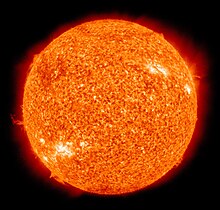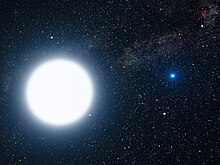Formation and evolution

Stellar evolution of low-mass (left cycle) and high-mass (right cycle) stars, with examples in italics
Stars condense from regions of
space of higher matter density, yet those regions are less dense than within a
vacuum chamber. These regions—known as
molecular clouds—consist mostly of hydrogen, with about 23 to 28 percent helium and a few percent heavier elements. One example of such a star-forming region is the
Orion Nebula.
[61] Most stars form in groups of dozens to hundreds of thousands of stars.
[62] Massive stars in these groups may powerfully illuminate those clouds,
ionizing the hydrogen, and creating
H II regions. Such feedback effects, from star formation, may ultimately disrupt the cloud and prevent further star formation.
All stars spend the majority of their existence as
main sequence stars, fueled primarily by the nuclear fusion of hydrogen into helium within their cores. However, stars of different masses have markedly different properties at various stages of their development. The ultimate fate of more massive stars differs from that of less massive stars, as do their luminosities and the impact they have on their environment. Accordingly, astronomers often group stars by their mass:
[63]
- Very low mass stars, with masses below 0.5 M☉, are fully convective and distribute helium evenly throughout the whole star while on the main sequence. Therefore, they never undergo shell burning, never become red giants, which cease fusing and become helium white dwarfs and slowly cool after exhausting their hydrogen.[64] However, as the lifetime of 0.5 M☉ stars is longer than the age of the universe, no such star has yet reached the white dwarf stage.
- Low mass stars (including the Sun), with a mass between 0.5 M☉ and 1.8–2.5 M☉ depending on composition, do become red giants as their core hydrogen is depleted and they begin to burn helium in core in a helium flash; they develop a degenerate carbon-oxygen core later on the asymptotic giant branch; they finally blow off their outer shell as a planetary nebula and leave behind their core in the form of a white dwarf.
- Intermediate-mass stars, between 1.8–2.5 M☉ and 5–10 M☉, pass through evolutionary stages similar to low mass stars, but after a relatively short period on the red giant branch they ignite helium without a flash and spend an extended period in the red clump before forming a degenerate carbon-oxygen core.
- Massive stars generally have a minimum mass of 7–10 M☉ (possibly as low as 5–6 M☉). After exhausting the hydrogen at the core these stars become supergiants and go on to fuse elements heavier than helium. They end their lives when their cores collapse and they explode as supernovae.
Star formation
The formation of a star begins with gravitational instability within a molecular cloud, caused by regions of higher density—often triggered by compression of clouds by radiation from massive stars, expanding bubbles in the interstellar medium, the collision of different molecular clouds, or the
collision of galaxies (as in a
starburst galaxy).
[65][66] When a region reaches a sufficient density of matter to satisfy the criteria for
Jeans instability, it begins to collapse under its own gravitational force.
[67]
As the cloud collapses, individual conglomerations of dense dust and gas form "
Bok globules". As a globule collapses and the density increases, the gravitational energy converts into heat and the temperature rises. When the protostellar cloud has approximately reached the stable condition of
hydrostatic equilibrium, a
protostar forms at the core.
[68] These
pre-main-sequence stars are often surrounded by a
protoplanetary disk and powered mainly by the conversion of gravitational energy. The period of gravitational contraction lasts about 10 to 15 million years.
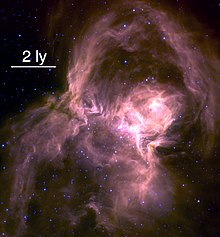
A cluster of approximately 500 young stars lies within the nearby
W40 stellar nursery.
Early stars of less than 2
M☉ are called
T Tauri stars, while those with greater mass are
Herbig Ae/Be stars. These newly formed stars emit jets of gas along their axis of rotation, which may reduce the
angular momentum of the collapsing star and result in small patches of nebulosity known as
Herbig–Haro objects.
[69][70] These jets, in combination with radiation from nearby massive stars, may help to drive away the surrounding cloud from which the star was formed.
[71]
Early in their development, T Tauri stars follow the
Hayashi track—they contract and decrease in luminosity while remaining at roughly the same temperature. Less massive T Tauri stars follow this track to the main sequence, while more massive stars turn onto the
Henyey track.
Most stars are observed to be members of binary star systems, and the properties of those binaries are the result of the conditions in which they formed.
[72] A gas cloud must lose its angular momentum in order to collapse and form a star. The fragmentation of the cloud into multiple stars distributes some of that angular momentum. The primordial binaries transfer some angular momentum by gravitational interactions during close encounters with other stars in young stellar clusters. These interactions tend to split apart more widely separated (soft) binaries while causing hard binaries to become more tightly bound. This produces the separation of binaries into their two observed populations distributions.
Main sequence
Stars spend about 90% of their existence fusing hydrogen into helium in high-temperature and high-pressure reactions near the core. Such stars are said to be on the
main sequence, and are called dwarf stars. Starting at zero-age main sequence, the proportion of helium in a star's core will steadily increase, the rate of nuclear fusion at the core will slowly increase, as will the star's temperature and luminosity.
[73] The Sun, for example, is estimated to have increased in luminosity by about 40% since it reached the main sequence 4.6 billion (4.6 × 10
9) years ago.
[74]
Every star generates a
stellar wind of particles that causes a continual outflow of gas into space. For most stars, the mass lost is negligible. The Sun loses 10
−14 M☉ every year,
[75] or about 0.01% of its total mass over its entire lifespan. However, very massive stars can lose 10
−7 to 10
−5 M☉ each year, significantly affecting their evolution.
[76] Stars that begin with more than 50
M☉ can lose over half their total mass while on the main sequence.
[77]
The time a star spends on the main sequence depends primarily on the amount of fuel it has and the rate at which it fuses it. The Sun is expected to live 10 billion (10
10) years. Massive stars consume their fuel very rapidly and are short-lived. Low mass stars consume their fuel very slowly. Stars less massive than 0.25
M☉, called
red dwarfs, are able to fuse nearly all of their mass while stars of about 1
M☉ can only fuse about 10% of their mass. The combination of their slow fuel-consumption and relatively large usable fuel supply allows low mass stars to last about one trillion (10
12) years; the most extreme of 0.08
M☉) will last for about 12 trillion years. Red dwarfs become
hotter and more luminous as they accumulate helium. When they eventually run out of hydrogen, they contract into a white dwarf and decline in temperature.
[64] However, since the lifespan of such stars is greater than the current
age of the universe (13.8 billion years), no stars under about 0.85
M☉[78] are expected to have moved off the main sequence.
Besides mass, the elements heavier than helium can play a significant role in the evolution of stars. Astronomers label all elements heavier than helium "metals", and call the chemical
concentration of these elements in a star, its
metallicity. A star's metallicity can influence the time the star takes to burn its fuel, and controls the formation of its magnetic fields,
[79] which affects the strength of its stellar wind.
[80] Older,
population II stars have substantially less metallicity than the younger, population I stars due to the composition of the molecular clouds from which they formed. Over time, such clouds become increasingly enriched in heavier elements as older stars die and shed portions of their
atmospheres.
Post–main sequence
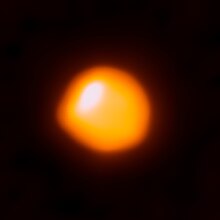
This orange blob shows the star Betelgeuse, as seen by the
Atacama Large Millimeter/submillimeter Array (ALMA). This is the first time that ALMA has ever observed the surface of a star and this first attempt has resulted in the highest-resolution image of Betelgeuse available.
As stars of at least 0.4
M☉[4] exhaust their supply of hydrogen at their core, they start to fuse hydrogen in a shell outside the helium core. Their outer layers expand and cool greatly as they form a
red giant. In about 5 billion years, when the Sun enters the helium burning phase, it will expand to a maximum radius of roughly 1
astronomical unit (150 million kilometres), 250 times its present size, and lose 30% of its current mass.
[74][81]
As the hydrogen shell burning produces more helium, the core increases in mass and temperature. In a red giant of up to 2.25
M☉, the mass of the helium core becomes degenerate prior to
helium fusion. Finally, when the temperature increases sufficiently, helium fusion begins explosively in what is called a
helium flash, and the star rapidly shrinks in radius, increases its surface temperature, and moves to the
horizontal branch of the HR diagram. For more massive stars, helium core fusion starts before the core becomes degenerate, and the star spends some time in the
red clump, slowly burning helium, before the outer convective envelope collapses and the star then moves to the horizontal branch.
[6]
After the star has fused the helium of its core, the carbon product fuses producing a hot core with an outer shell of fusing helium. The star then follows an evolutionary path called the
asymptotic giant branch (AGB) that parallels the other described red giant phase, but with a higher luminosity. The more massive AGB stars may undergo a brief period of carbon fusion before the core becomes degenerate.
Massive stars
During their helium-burning phase, a star of more than 9 solar masses expands to form first a
blue and then a
red supergiant. Particularly massive stars may evolve to a
Wolf-Rayet star, characterised by spectra dominated by emission lines of elements heavier than hydrogen, which have reached the surface due to strong convection and intense mass loss.
When helium is exhausted at the core of a massive star, the core contracts and the temperature and pressure rises enough to fuse
carbon (see
Carbon-burning process). This process continues, with the successive stages being fueled by
neon (see
neon-burning process),
oxygen (see
oxygen-burning process), and
silicon (see
silicon-burning process). Near the end of the star's life, fusion continues along a series of onion-layer shells within a massive star. Each shell fuses a different element, with the outermost shell fusing hydrogen; the next shell fusing helium, and so forth.
[82]
The final stage occurs when a massive star begins producing
iron. Since iron nuclei are more
tightly bound than any heavier nuclei, any fusion beyond iron does not produce a net release of energy. To a very limited degree such a process proceeds, but it consumes energy. Likewise, since they are more tightly bound than all lighter nuclei, such energy cannot be released by
fission.
[83]
Collapse
As a star's core shrinks, the intensity of radiation from that surface increases, creating such
radiation pressure on the outer shell of gas that it will push those layers away, forming a
planetary nebula. If what remains after the outer atmosphere has been shed is less than roughly 1.4
M☉, it shrinks to a relatively tiny object about the size of Earth, known as a
white dwarf. White dwarfs lack the mass for further gravitational compression to take place.
[84] The
electron-degenerate matter inside a white dwarf is no longer a plasma, even though stars are generally referred to as being spheres of plasma. Eventually, white dwarfs fade into
black dwarfs over a very long period of time.
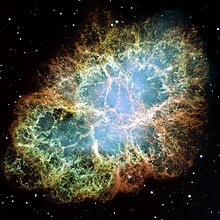
The
Crab Nebula, remnants of a supernova that was first observed around 1050 AD
In massive stars, fusion continues until the iron core has grown so large (more than 1.4
M☉) that it can no longer support its own mass. This core will suddenly collapse as its electrons are driven into its protons, forming neutrons, neutrinos, and gamma rays in a burst of
electron capture and
inverse beta decay. The
shockwave formed by this sudden collapse causes the rest of the star to explode in a supernova. Supernovae become so bright that they may briefly outshine the star's entire home galaxy. When they occur within the Milky Way, supernovae have historically been observed by naked-eye observers as "new stars" where none seemingly existed before.
[85]
A supernova explosion blows away the star's outer layers, leaving a
remnant such as the Crab Nebula.
[85] The core is compressed into a
neutron star, which sometimes manifests itself as a
pulsar or
X-ray burster. In the case of the largest stars, the remnant is a black hole greater than 4
M☉.
[86] In a neutron star the matter is in a state known as
neutron-degenerate matter, with a more exotic form of degenerate matter,
QCD matter, possibly present in the core. Within a black hole, the matter is in a state that is not currently understood.
The blown-off outer layers of dying stars include heavy elements, which may be recycled during the formation of new stars. These heavy elements allow the formation of rocky planets. The outflow from supernovae and the stellar wind of large stars play an important part in shaping the interstellar medium.
[85]
Binary stars
The post–main-sequence evolution of binary stars may be significantly different from the evolution of single stars of the same mass. If stars in a binary system are sufficiently close, when one of the stars expands to become a red giant it may overflow its
Roche lobe, the region around a star where material is gravitationally bound to that star, leading to transfer of material to the other. When the Roche lobe is violated, a variety of phenomena can result, including
contact binaries,
common-envelope binaries,
cataclysmic variables, and
type Ia supernovae.
Distribution
Stars are not spread uniformly across the universe, but are normally grouped into galaxies along with interstellar gas and dust. A typical galaxy contains hundreds of billions of stars, and there are more than 2 trillion (10
12) galaxies.
[87] Overall, there are as many as an estimated
1×1024 stars
[1][2] (more stars than all the
grains of sand on planet
Earth).
[88][89][90] While it is often believed that stars only exist within galaxies, intergalactic stars have been discovered.
[91]
A
multi-star system consists of two or more gravitationally bound stars that orbit each other. The simplest and most common multi-star system is a binary star, but systems of three or more stars are also found. For reasons of orbital stability, such multi-star systems are often organized into hierarchical sets of binary stars.
[92] Larger groups called star clusters also exist. These range from loose
stellar associations with only a few stars, up to enormous
globular clusters with hundreds of thousands of stars. Such systems orbit their host galaxy.
It has been a long-held assumption that the majority of stars occur in gravitationally bound, multiple-star systems. This is particularly true for very massive O and B class stars, where 80% of the stars are believed to be part of multiple-star systems. The proportion of single star systems increases with decreasing star mass, so that only 25% of red dwarfs are known to have stellar companions. As 85% of all stars are red dwarfs, most stars in the Milky Way are likely single from birth.
[93]
The nearest star to the Earth, apart from the Sun, is
Proxima Centauri, which is 39.9 trillion kilometres, or 4.2 light-years. Travelling at the orbital speed of the
Space Shuttle (8 kilometres per second—almost 30,000 kilometres per hour), it would take about 150,000 years to arrive.
[94] This is typical of stellar separations in
galactic discs.
[95] Stars can be much closer to each other in the centres of galaxies and in
globular clusters, or much farther apart in
galactic halos.
Due to the relatively vast distances between stars outside the galactic nucleus, collisions between stars are thought to be rare. In denser regions such as the core of globular clusters or the galactic center, collisions can be more common.
[96] Such collisions can produce what are known as
blue stragglers. These abnormal stars have a higher surface temperature than the other main sequence stars with the same luminosity of the cluster to which it belongs.
[97]
Characteristics
Almost everything about a star is determined by its initial mass, including such characteristics as luminosity, size, evolution, lifespan, and its eventual fate.
Age
Most stars are between 1 billion and 10 billion years old. Some stars may even be close to 13.8 billion years old—the observed
age of the universe. The oldest star yet discovered,
HD 140283, nicknamed Methuselah star, is an estimated 14.46 ± 0.8 billion years old.
[98] (Due to the uncertainty in the value, this age for the star does not conflict with the age of the Universe, determined by the
Planck satellite as 13.799 ± 0.021).
[98][99]
The more massive the star, the shorter its lifespan, primarily because massive stars have greater pressure on their cores, causing them to burn hydrogen more rapidly. The most massive stars last an average of a few million years, while stars of minimum mass (red dwarfs) burn their fuel very slowly and can last tens to hundreds of billions of years.
[100][101]Lifetimes of stages of stellar evolution in billions of years[102]
| Initial Mass (M☉) | Main Sequence | Subgiant | First Red Giant | Core He Burning |
|---|
| 1.0 | 7.41 | 2.63 | 1.45 | 0.95 |
| 1.5 | 1.72 | 0.41 | 0.18 | 0.26 |
| 2.0 | 0.67 | 0.11 | 0.04 | 0.10 |
Chemical composition
When stars form in the present Milky Way galaxy they are composed of about 71% hydrogen and 27% helium,
[103] as measured by mass, with a small fraction of heavier elements. Typically the portion of heavy elements is measured in terms of the iron content of the stellar atmosphere, as iron is a common element and its absorption lines are relatively easy to measure. The portion of heavier elements may be an indicator of the likelihood that the star has a planetary system.
[104]
The star with the lowest iron content ever measured is the dwarf HE1327-2326, with only 1/200,000th the iron content of the Sun.
[105] By contrast, the super-metal-rich star
μ Leonis has nearly double the abundance of iron as the Sun, while the planet-bearing star
14 Herculis has nearly triple the iron.
[106] There also exist chemically
peculiar stars that show unusual abundances of certain elements in their spectrum; especially
chromium and
rare earth elements.
[107] Stars with cooler outer atmospheres, including the Sun, can form various diatomic and polyatomic molecules.
[108]
Diameter

Some of the well-known stars with their apparent colors and relative sizes.
Due to their great distance from the Earth, all stars except the Sun appear to the unaided eye as shining points in the
night sky that
twinkle because of the effect of the Earth's atmosphere. The Sun is also a star, but it is close enough to the Earth to appear as a disk instead, and to provide daylight. Other than the Sun, the star with the largest apparent size is
R Doradus, with an
angular diameter of only 0.057
arcseconds.
[109]
The disks of most stars are much too small in
angular size to be observed with current ground-based optical telescopes, and so
interferometer telescopes are required to produce images of these objects. Another technique for measuring the angular size of stars is through
occultation. By precisely measuring the drop in brightness of a star as it is occulted by the
Moon (or the rise in brightness when it reappears), the star's angular diameter can be computed.
[110]
Kinematics
The motion of a star relative to the Sun can provide useful information about the origin and age of a star, as well as the structure and evolution of the surrounding galaxy. The components of motion of a star consist of the
radial velocity toward or away from the Sun, and the traverse angular movement, which is called its
proper motion.
Radial velocity is measured by the
doppler shift of the star's spectral lines, and is given in units of km/
s. The proper motion of a star, its
parallax, is determined by precise astrometric measurements in units of milli-
arc seconds (mas) per year. With knowledge of the star's parallax and its distance, the proper motion velocity can be calculated. Together with the radial velocity, the total velocity can be calculated. Stars with high rates of proper motion are likely to be relatively close to the Sun, making them good candidates for parallax measurements.
[115]
When both rates of movement are known, the
space velocity of the star relative to the Sun or the galaxy can be computed. Among nearby stars, it has been found that younger population I stars have generally lower velocities than older, population II stars. The latter have elliptical orbits that are inclined to the plane of the galaxy.
[116] A comparison of the kinematics of nearby stars has allowed astronomers to trace their origin to common points in giant molecular clouds, and are referred to as
stellar associations.
[117]
Magnetic field
The
magnetic field of a star is generated within regions of the interior where
convective circulation occurs. This movement of conductive plasma functions like a
dynamo, wherein the movement of electrical charges induce magnetic fields, as does a mechanical dynamo. Those magnetic fields have a great range that extend throughout and beyond the star. The strength of the magnetic field varies with the mass and composition of the star, and the amount of magnetic surface activity depends upon the star's rate of rotation. This surface activity produces
starspots, which are regions of strong magnetic fields and lower than normal surface temperatures.
Coronal loops are arching magnetic field flux lines that rise from a star's surface into the star's outer atmosphere, its corona. The coronal loops can be seen due to the plasma they conduct along their length.
Stellar flares are bursts of high-energy particles that are emitted due to the same magnetic activity.
[118]
Young, rapidly rotating stars tend to have high levels of surface activity because of their magnetic field. The magnetic field can act upon a star's stellar wind, functioning as a brake to gradually slow the rate of rotation with time. Thus, older stars such as the Sun have a much slower rate of rotation and a lower level of surface activity. The activity levels of slowly rotating stars tend to vary in a cyclical manner and can shut down altogether for periods of time.
[119] During the
Maunder Minimum, for example, the Sun underwent a 70-year period with almost no sunspot activity.
Mass
One of the most massive stars known is
Eta Carinae,
[120] which, with 100–150 times as much mass as the Sun, will have a lifespan of only several million years. Studies of the most massive
open clusters suggests 150
M☉ as an upper limit for stars in the current era of the universe.
[121] This represents an empirical value for the theoretical limit on the mass of forming stars due to increasing radiation pressure on the accreting gas cloud. Several stars in the
R136 cluster in the
Large Magellanic Cloud have been measured with larger masses,
[122] but it has been determined that they could have been created through the collision and merger of massive stars in close binary systems, sidestepping the 150
M☉ limit on massive star formation.
[123]
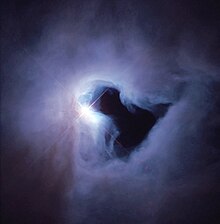
The
reflection nebula NGC 1999 is brilliantly illuminated by V380 Orionis (center), a variable star with about 3.5 times the mass of the Sun. The black patch of sky is a vast hole of empty space and not a
dark nebula as previously thought.
The first stars to form after the Big Bang may have been larger, up to 300
M☉,
[124] due to the complete absence of elements heavier than
lithium in their composition. This generation of supermassive
population III stars is likely to have existed in the very early universe (i.e., they are observed to have a high redshift), and may have started the production of
chemical elements heavier than
hydrogen that are needed for the later formation of
planets and
life. In June 2015, astronomers reported evidence for
Population III stars in the
Cosmos Redshift 7 galaxy at
z = 6.60.
[125][126]
With a mass only 80 times that of
Jupiter (
MJ),
2MASS J0523-1403 is the smallest known star undergoing nuclear fusion in its core.
[127] For stars with metallicity similar to the Sun, the theoretical minimum mass the star can have and still undergo fusion at the core, is estimated to be about 75
MJ.
[128][129] When the metallicity is very low, however, the minimum star size seems to be about 8.3% of the solar mass, or about 87
MJ.
[129][130] Smaller bodies called
brown dwarfs, occupy a poorly defined grey area between stars and
gas giants.
The combination of the radius and the mass of a star determines its surface gravity. Giant stars have a much lower surface gravity than do main sequence stars, while the opposite is the case for degenerate, compact stars such as white dwarfs. The surface gravity can influence the appearance of a star's spectrum, with higher gravity causing a broadening of the
absorption lines.
[35]
Rotation
The rotation rate of stars can be determined through
spectroscopic measurement, or more exactly determined by tracking their
starspots. Young stars can have a rotation greater than 100 km/s at the equator. The B-class star
Achernar, for example, has an equatorial velocity of about 225 km/s or greater, causing its
equator to bulge outward and giving it an equatorial diameter that is more than 50% greater than between the poles. This rate of rotation is just below the critical velocity of 300 km/s at which speed the star would break apart.
[131] By contrast, the Sun rotates once every 25–35 days depending on latitude,
[132] with an equatorial velocity of 1.93 km/s.
[133] A
main sequence star's magnetic field and the stellar wind serve to slow its rotation by a significant amount as it evolves on the main sequence.
[134]
Degenerate stars have contracted into a compact mass, resulting in a rapid rate of rotation. However they have relatively low rates of rotation compared to what would be expected by conservation of
angular momentum—the tendency of a rotating body to compensate for a contraction in size by increasing its rate of spin. A large portion of the star's angular momentum is dissipated as a result of mass loss through the stellar wind.
[135] In spite of this, the rate of rotation for a pulsar can be very rapid. The pulsar at the heart of the
Crab nebula, for example, rotates 30 times per second.
[136] The rotation rate of the pulsar will gradually slow due to the emission of radiation.
[137]

